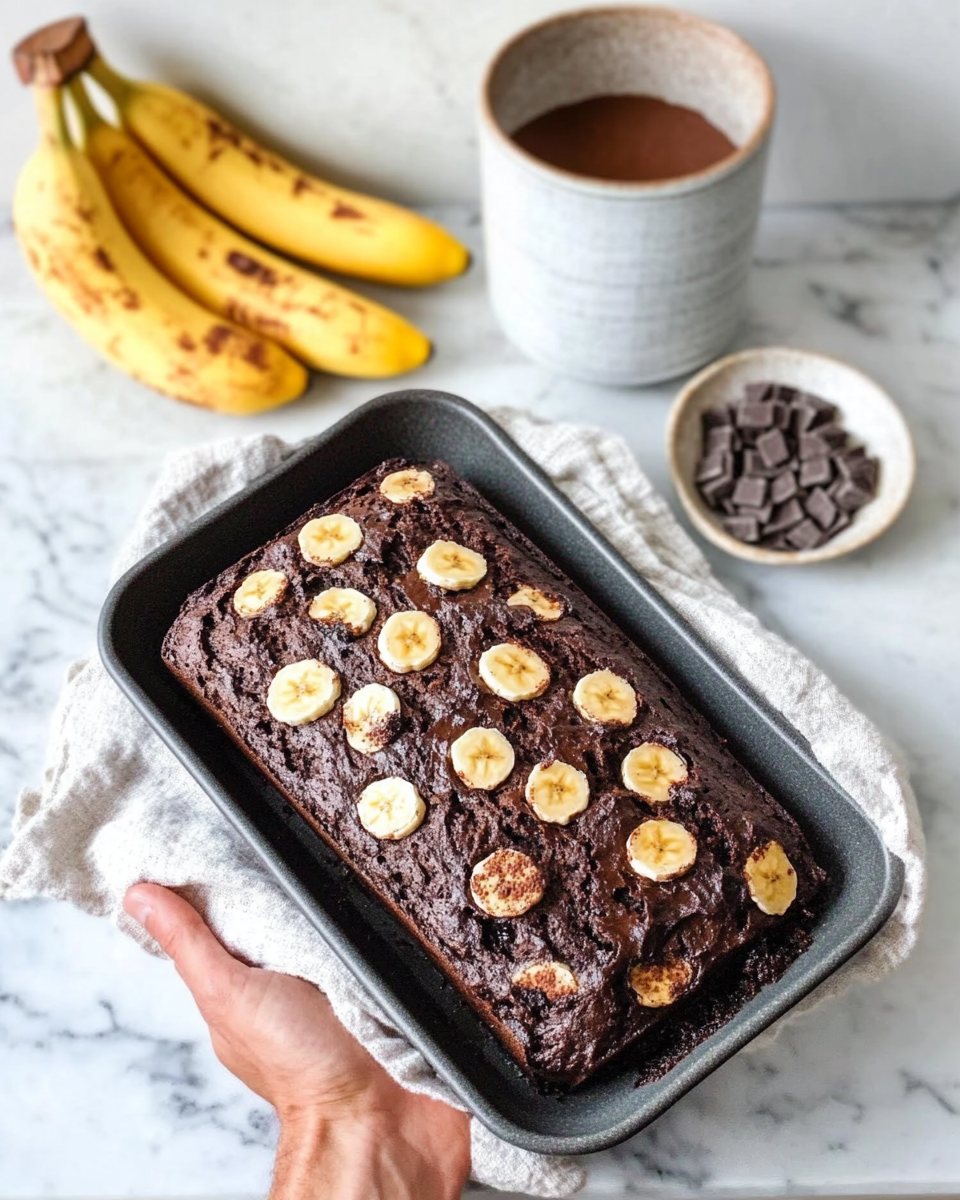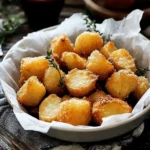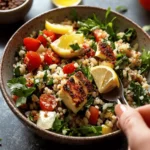This vegan chocolate banana bread is a moist, rich, and naturally sweet treat made without any animal products. Coconut oil adds a subtle tropical flavor and keeps the bread tender, while ripe bananas and cocoa create a perfect balance of sweetness and chocolatey goodness. It’s an ideal snack or dessert for those seeking a healthier, plant-based option.
FULL RECIPE
Ingredients
- 3 ripe bananas, mashed
- 1/3 cup coconut oil, melted
- 3/4 cup brown sugar or coconut sugar
- 1/4 cup plant-based milk (almond, soy, oat, etc.)
- 1 teaspoon vanilla extract
- 1 1/2 cups all-purpose flour or whole wheat flour
- 1/4 cup cocoa powder
- 1 teaspoon baking soda
- 1/2 teaspoon baking powder
- 1/4 teaspoon salt
- 1/2 cup vegan chocolate chips (optional)
Directions
- Preheat oven to 350°F (175°C). Grease a 9×5-inch loaf pan or line it with parchment paper.
- In a large bowl, mix mashed bananas, melted coconut oil, sugar, plant-based milk, and vanilla extract until smooth.
- In a separate bowl, whisk together flour, cocoa powder, baking soda, baking powder, and salt.
- Gradually add the dry ingredients to the wet mixture, stirring gently until just combined.
- Fold in vegan chocolate chips if using.
- Pour batter into the prepared loaf pan and smooth the top.
- Bake for 50-60 minutes, or until a toothpick inserted in the center comes out clean.
- Let the bread cool in the pan for 10 minutes, then transfer to a wire rack to cool completely before slicing.
Nutritional Information
- Calories: 180
- Fat: 7g (mostly from coconut oil)
- Saturated Fat: 5g
- Carbohydrates: 28g
- Fiber: 3g
- Sugar: 14g
- Protein: 2g
Health Benefits of Vegan Chocolate Banana Bread
Vegan chocolate banana bread is not only delicious but also offers several health benefits. The use of ripe bananas provides a natural source of potassium, which supports heart health and muscle function. Bananas also contain dietary fiber that promotes digestive health and helps maintain steady blood sugar levels. Coconut oil, used instead of butter or other fats, contains medium-chain triglycerides (MCTs) which are quickly metabolized and can provide a quick source of energy. Cocoa powder is rich in antioxidants called flavonoids, which help reduce inflammation and improve heart health. Overall, this bread combines nutritious ingredients that contribute to better well-being without sacrificing taste.
Why Choose Vegan Baking?
Choosing vegan baking means avoiding all animal products, including dairy and eggs, which can reduce the environmental footprint and cater to ethical concerns about animal welfare. Vegan recipes often rely on whole-food ingredients and plant-based fats, making them lighter and sometimes easier to digest. Vegan baking can also be suitable for people with dairy or egg allergies. By using ingredients like bananas and coconut oil, this bread stays moist and flavorful without needing animal-based components, showcasing how creative and delicious vegan baking can be.
The Role of Bananas in Baking
Bananas serve multiple purposes in baking beyond just flavor. Their natural sweetness reduces the need for added sugars, making the final product healthier. They act as a binder, replacing eggs, which helps hold the bread together. The moisture from bananas keeps the bread tender and soft, preventing it from drying out. Additionally, the banana’s unique texture enhances the crumb of the bread, giving it a pleasant chewiness that complements the chocolate perfectly.
Coconut Oil vs Other Fats
Coconut oil is a popular vegan fat due to its texture and subtle flavor. Compared to vegetable oils, coconut oil is solid at room temperature, which helps create a denser and richer texture in baked goods. It also contains saturated fats, but these are primarily medium-chain fatty acids that differ from those in animal fats. Many bakers choose coconut oil for its tropical aroma and ability to mimic the richness of butter in vegan recipes. It also helps keep the bread moist for longer periods.
Understanding Cocoa Powder in Baking
Cocoa powder is a concentrated source of chocolate flavor without added fat or sugar. It’s important to distinguish between natural and Dutch-processed cocoa powders when baking, as each reacts differently with leavening agents. Natural cocoa is more acidic and pairs well with baking soda, while Dutch-processed cocoa is alkalized and typically used with baking powder. In this recipe, the cocoa powder provides a deep chocolate flavor, balancing the sweetness of the bananas and sugar.
Sugar Alternatives in Vegan Baking
Brown sugar or coconut sugar is commonly used in vegan baking to add sweetness and moisture. Coconut sugar is considered a lower glycemic index sweetener compared to refined white sugar, which can be better for blood sugar control. Both sugars add a caramel-like flavor that complements the banana and chocolate notes. Adjusting the amount and type of sugar can customize the sweetness level according to personal preference or dietary needs.
How Plant-Based Milks Affect Texture
The use of plant-based milks such as almond, oat, or soy milk adds moisture without dairy. Each type of milk contributes a subtle difference in flavor and texture. For example, oat milk is creamier and slightly sweet, making it a great option for baking, while almond milk offers a lighter texture. These milks hydrate the dry ingredients and help develop the crumb structure, ensuring the bread stays tender and soft.
The Importance of Leavening Agents
Baking soda and baking powder are crucial in this recipe for achieving the right rise and texture. Baking soda reacts with the acidity in the bananas and cocoa to release carbon dioxide, which helps the bread expand and become airy. Baking powder adds an additional lift, ensuring the bread isn’t too dense. Proper measurement and balance of these agents prevent the bread from becoming heavy or gummy.
Vegan Chocolate Chips for Extra Flavor
Adding vegan chocolate chips enhances the texture and flavor of the bread, giving bursts of melted chocolate in every bite. Vegan chocolate chips are dairy-free and often made with cocoa solids, sugar, and cocoa butter. They complement the cocoa powder’s deep flavor while adding a contrasting texture. Using chips also makes the bread more visually appealing and indulgent.
Tips for Achieving Moistness
Moistness is key in banana bread, and this recipe achieves it through the combination of ripe bananas, coconut oil, and plant-based milk. Using very ripe bananas increases natural sugars and moisture, while coconut oil prevents the bread from drying out during baking. Avoiding overmixing preserves the texture and prevents gluten development that can make the bread tough.
Shelf Life and Storage Suggestions
Proper storage is important to keep the bread fresh and moist. Wrapped tightly in plastic wrap or stored in an airtight container, the bread can last up to four days at room temperature. Refrigeration extends shelf life but may dry the bread slightly, so letting it come to room temperature before eating is recommended. The bread also freezes well; slice it beforehand and store in freezer bags for convenient thawing.
Variations and Add-ins
This recipe is versatile and can be adapted by adding nuts such as walnuts or pecans for crunch, shredded coconut for extra tropical flavor, or dried fruits like cranberries or raisins for sweetness. Spices such as cinnamon or nutmeg can add warmth and depth. These variations personalize the bread and provide texture contrasts that enhance the eating experience.
Environmental Impact of Vegan Baking
Vegan baking generally has a lower environmental impact compared to traditional baking that relies on animal products. Plant-based ingredients require less water, land, and energy to produce, reducing carbon emissions. Choosing organic or sustainably sourced ingredients further minimizes environmental harm. Baking at home with such recipes encourages mindful consumption and reduces reliance on processed goods.
Gluten-Free Adaptation Options
For those who require gluten-free diets, this recipe can be modified by substituting all-purpose flour with gluten-free flour blends. Using a mix that contains xanthan gum or guar gum helps replicate the texture and binding properties of gluten. Careful adjustment of liquid ingredients may be necessary to maintain moisture. Gluten-free versions offer accessibility without compromising flavor.
Cultural Popularity of Banana Bread
Banana bread has a longstanding place in baking traditions worldwide, especially in countries with abundant banana production. It emerged as a popular recipe during times when food waste reduction was emphasized, making use of overripe bananas that might otherwise be discarded. Its simple ingredients and comforting flavor have made it a staple in many households and a beloved treat for all ages.
Baking Tips for Perfect Texture
Achieving the perfect texture requires attention to ingredient temperature and mixing technique. Using room temperature ingredients helps them combine more evenly. Mixing the batter just until ingredients are incorporated prevents overworking the flour, which can lead to dense bread. Checking the bread early and avoiding overbaking ensures it stays soft and moist.
Nutritional Balance and Moderation
While this bread contains nutritious ingredients, it is still a sweet treat and should be enjoyed in moderation as part of a balanced diet. The natural sugars in bananas and added sugars contribute to calorie intake. Pairing a slice with a source of protein or healthy fat can provide a more satisfying snack and help manage hunger.
Pairing Suggestions
Vegan chocolate banana bread pairs wonderfully with plant-based spreads like almond butter or coconut yogurt. It can be served warm with a drizzle of maple syrup or alongside a cup of coffee or tea for a comforting snack. For a more indulgent dessert, topping with vegan whipped cream or fresh berries adds contrast in flavor and texture.
Advertisement
Kid-Friendly and Allergy-Friendly
This recipe is ideal for families as it avoids common allergens like eggs and dairy. Its natural sweetness and chocolate flavor make it appealing to children, encouraging them to enjoy plant-based foods. Adjusting sugar levels or swapping ingredients allows it to fit various dietary restrictions while remaining tasty and fun to eat.
Conclusion
Vegan chocolate banana bread is a versatile and nutritious baked good that showcases how plant-based ingredients can create indulgent yet health-conscious treats. Its combination of ripe bananas, coconut oil, and rich cocoa powder results in a moist, flavorful bread that satisfies sweet cravings without relying on animal products. Adaptable to dietary needs and easy to prepare, it is perfect for anyone seeking a delicious vegan dessert or snack. Whether enjoyed fresh from the oven or stored for later, this bread offers a wonderful balance of taste, texture, and nourishment. It also encourages sustainable and ethical baking practices, making it a recipe worth adding to your regular rotation.






